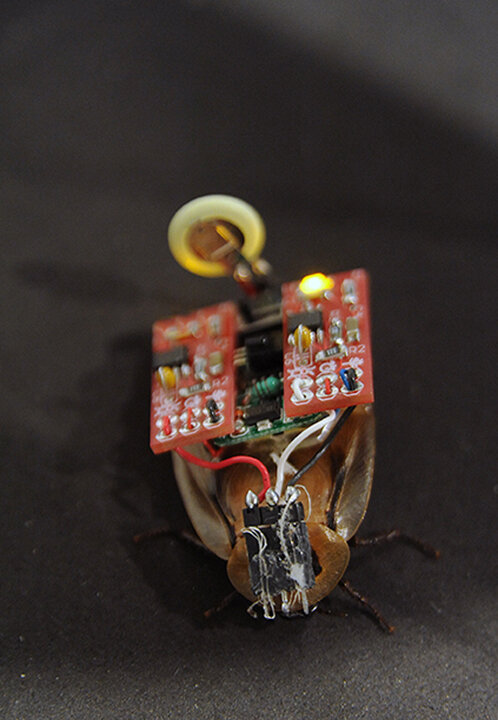


tweet roach, 2012, hacked electronic circuit from backyard brains, live cockroach, twitter, human twitter users
In the 1997 movie The Fifth Element, an unlikely spy, a cockroach who makes a cameo appearance, makes its way into a boardroom and slowly scurries across a shiny silver table. Outfitted with a wireless remote controlled circuit and spy camera, a human on the outside steers the insect closer to gather video of a top secret conversation. As you might recall in the scene, eventually the insect meets its instant and deadly fate with the bottom of a shiny black black shoe. The smashed insect parts, viscous and mixed with the remains of the hard plastic bits of the once complex circuit, are now nothing but gunk on the bottom of another shoe.
The concept of cyborgian life is nothing new to us as humans. As we delve farther into a world where we have augmented ourselves with ever evolving technological bodily extensions, these extensions have also found themselves present in the non-human world through our intervention. The cockroach (and other “pest” labeled insects) have not found themselves devoid from this intervention and experimentation. Researchers have been actively outfitting insects with “electronic backpacks” for decades. Embedding their mucoidal exoskeletons with advanced technologies for various scientific purposes is hardly uncommon. Currently we find ourselves in a time where one no longer needs to have deep pockets or an advanced degree to see their very own insect cyborg come to life. The ability to use the internet or even simply participate in the internet is all that one needs.
Twitter Roach (@TweetRoach) is an experimental installation that utilizes the basics of the internet, entry level electronics and programming, and a kit purchased with a Paypal account. Utilizing the Beta version of the Generation 4 RoboRoach kit produced and sold by Backyard Brains (roboroach.backyardbrains.com), custom processing and arduino programming and circuitry, it allows individuals to log into their twitter accounts to cooperatively attempt to affect the movement of a cockroach from anywhere in the world by tweeting and using hashtags. Twitter Roach (@TweetRoach), is designed to parse specific commands received through mentions and hashtags. When the correct combination of mentions and hashtags has been tweeted by a user, Twitter Roach wirelessly sends a command to the RoboRoach interface attached to the cockroach to stimulate one of its two antennae connected to the circuit which essentially makes the insect feel as if its antennae have touched something. Thus in theory, the tweets and hashtags guide the cockroach to move through its given space.
This experimental piece, in its beta phase, questions the collective notions of the Hive Mind that can form through social media platforms, its impact on the individual mind of the cockroach, and the accessibility of cyborgian DIY citizen scientist technologies and their instant availability. Ultimately the project largely questions the impact on the architecture of the internet and accessibility in our current culture.